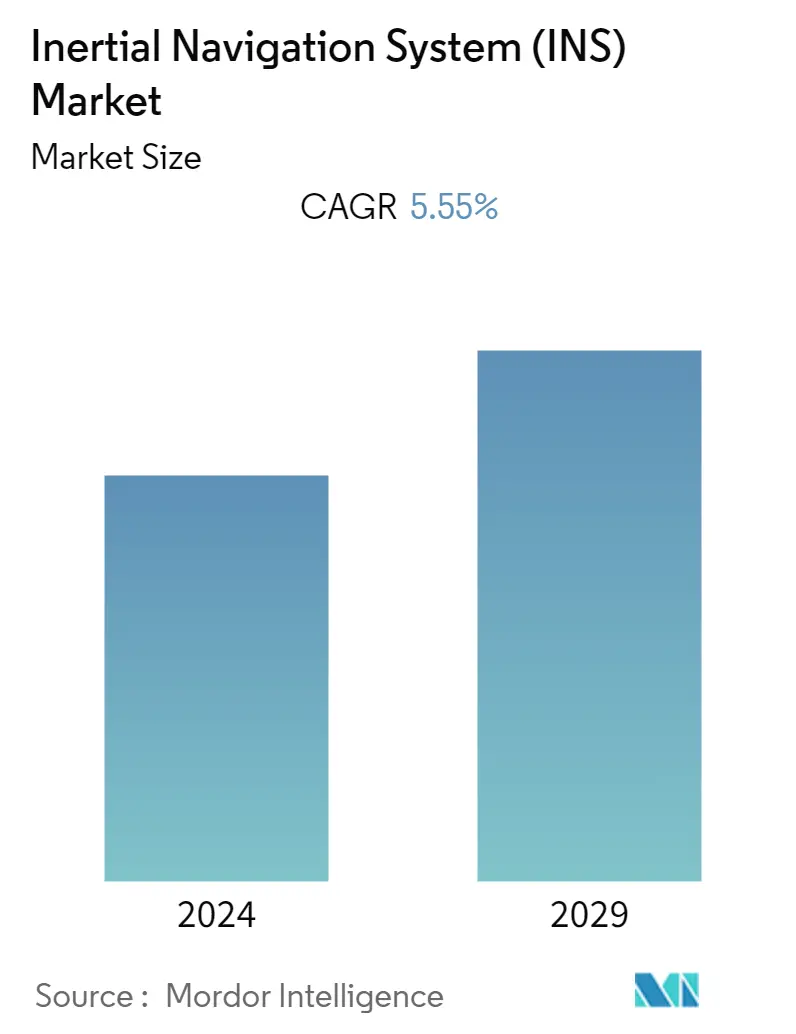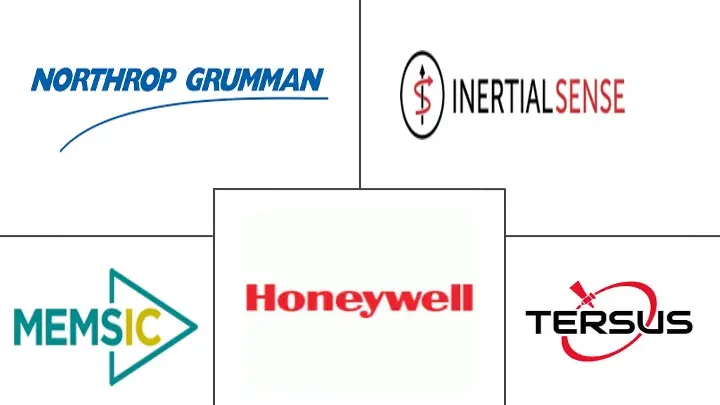Market Size of Inertial Navigation System (INS) Industry

| Study Period | 2019 - 2029 |
| Base Year For Estimation | 2023 |
| CAGR | 5.55 % |
| Fastest Growing Market | Asia Pacific |
| Largest Market | North America |
| Market Concentration | Medium |
Major Players
*Disclaimer: Major Players sorted in no particular order |
Inertial Navigation System (INS) Market Analysis
The inertial navigation system market is expected to grow at a CAGR of 5.55% over the forecast period (2021-2026). Inertial navigation system (INS) is a navigation technique in which accelerometers and gyroscopes provide measurements and are used to track an object's orientation and position relative to a known starting point, orientation, and velocity.
- INS is an autonomous system with excellent concealment. It is independent of any external information, which does not radiate energy to external space, making it applicable in sea, airspace, or underground. Since the inertial navigation system updates the data quickly and possesses the advantages of accuracy and stability with small size and lightweight, it can provide comprehensive navigation data, such as the location. Thus, the INS plays a critical role in military and civilian navigation.
- For instance, the US Navy awarded a contract to Northrop Grumman Corporation to develop the replacement inertial navigation system (INS-R) deployed on navy combat and support ships. INS-R provides increased navigation accuracy in challenging maritime combat environments.
- Inertial navigation systems are also suitable for unmanned systems, widely used on unmanned aerial vehicles (UAV) and unmanned underwater vehicles (UUV). These are extensively used across oil and gas and defense industries. UUVs are mainly used for counter-attacking, deactivating underwater mines, and port security in the defense sector. The INS employed in these unmanned systems provides better navigation and accurate positional data. This is expected to fuel demand during the forecast period.
- Increasing governmental measures concerning the adoption of unmanned vehicles in various countries are expected to impact the growth of the market studied. For instance, according to the Association for Unmanned Vehicle Systems International, the US military had proposed spending USD 9.6 billion in 2019 (which was an increase of 28% over the previous year) on unmanned vehicle systems.
- The inertial navigation system will be adopted in guiding autonomous cars. The INS, comprising an inertial measurement unit and other sensors, provides position, velocity, and attitude information of a vehicle. Aceinna, in 2019, launched a high-performance, dual-band, real-time kinematic inertial navigation system with built-in inertial sensors for automotive applications. The device, INS1000, embeds nine-degree-of-freedom inertial sensor technology to achieve automotive dead reckoning performance in GNSS-challenged environments, such as heavily tree-lined roads, tunnels, underpasses, and bridges.
- However, automakers have faced increased pressure to shut down their factories due to the COVID-19 pandemic. After governments started recommending that people stay in their homes as much as possible, it has caused supply chain disruptions across various industries.
Inertial Navigation System (INS) Industry Segmentation
An inertial navigation system (INS) is a navigation aid that uses a computer with reference to the computation process, which is used to control the initial velocity and position of a moving object irrespective of external positions, uses stable platform techniques. The inertial sensors in the system are installed on a constant stage and mechanically isolated from the vehicle's rotating motion by providing better systems integrity and allowing the navigation system to coast through short GPS outages with high accuracy.
| By End-user Industry | |
| Aerospace and Defense | |
| Marine | |
| Automotive | |
| Industrial |
| Geography | |
| North America | |
| Europe | |
| Asia-Pacific | |
| Rest of the World |
Inertial Navigation System (INS) Market Size Summary
The inertial navigation system (INS) market is poised for significant growth, driven by its critical role in both military and civilian navigation applications. INS technology, which utilizes accelerometers and gyroscopes to determine an object's position and orientation, is valued for its autonomy and ability to operate without external information, making it ideal for use in sea, air, and underground environments. The system's rapid data updating, accuracy, stability, and compactness make it indispensable for various applications, including unmanned aerial and underwater vehicles, as well as military and naval operations. The increasing adoption of unmanned vehicles and the growing demand for precise navigation in defense and aerospace sectors are key factors propelling market expansion. Additionally, advancements in technology and fresh investments in military applications are expected to further stimulate market growth.
The North American region is anticipated to hold a substantial share of the inertial navigation system market, primarily driven by demand in the defense sector. The region's focus on enhancing navigation and positioning solutions for combat platforms and maritime exploration activities underscores the importance of INS technology. Companies in North America are actively developing innovative products to meet the needs of various end-user verticals, with significant investments in next-generation systems. The competitive landscape of the INS market is characterized by the presence of major players who are continuously introducing advanced devices and solutions. Despite challenges such as long production times and technological obsolescence, the market remains dynamic, with ongoing advancements and strategic developments shaping its future trajectory.
Inertial Navigation System (INS) Market Size - Table of Contents
-
1. MARKET INSIGHTS
-
1.1 Market Overview
-
1.2 Industry Attractiveness - Porter's Five Force Analysis
-
1.2.1 Bargaining Power of Suppliers
-
1.2.2 Bargaining Power of Buyers/Consumers
-
1.2.3 Threat of New Entrants
-
1.2.4 Threat of Substitute Products
-
1.2.5 Intensity of Competitive Rivalry
-
-
1.3 Technology Snapshot
-
1.4 Impact of COVID-19 on the INS Market
-
-
2. MARKET SEGMENTATION
-
2.1 By End-user Industry
-
2.1.1 Aerospace and Defense
-
2.1.2 Marine
-
2.1.3 Automotive
-
2.1.4 Industrial
-
-
2.2 Geography
-
2.2.1 North America
-
2.2.2 Europe
-
2.2.3 Asia-Pacific
-
2.2.4 Rest of the World
-
-
Inertial Navigation System (INS) Market Size FAQs
What is the current Inertial Navigation System (INS) Market size?
The Inertial Navigation System (INS) Market is projected to register a CAGR of 5.55% during the forecast period (2024-2029)
Who are the key players in Inertial Navigation System (INS) Market?
Northrop Grumman Corporation, MEMSIC Inc., Tersus GNSS, Honeywell International Inc. and Intertial Sense Inc are the major companies operating in the Inertial Navigation System (INS) Market.

